The Reading Chair
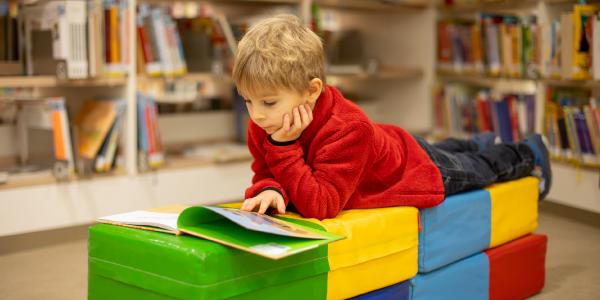
You are here
Educators and children alike deserve books that are rewarding on many levels and endlessly appealing. The best books delight—and teach. In this issue of The Reading Chair, we feature books that, although they take place across a variety of seasons and settings (gardens, a playground, a bustling market), highlight community and relationships. These stories feature characters’ interactions with and care for the natural world, their families, and their wider communities.
In Where Are the Eggs?, a girl cares for her chickens while exploring math concepts. What Does Little Crocodile Say at the Park? portrays young characters resolving a conflict on the playground as they interact with the world through sound, blending social and emotional themes with self-expression. City Beet celebrates community and ingenuity, while Mama Shamsi at the Bazaar shows a grandmother supporting a child through a new experience, a first visit to the market in Tehran. There Was a Party for Langston, King of Letters features a community celebration of poetry, history, and culture. All of these are books that you and the young readers in your care will want to read again and again.
—Isabel Baker and Miriam Baker Schiffer
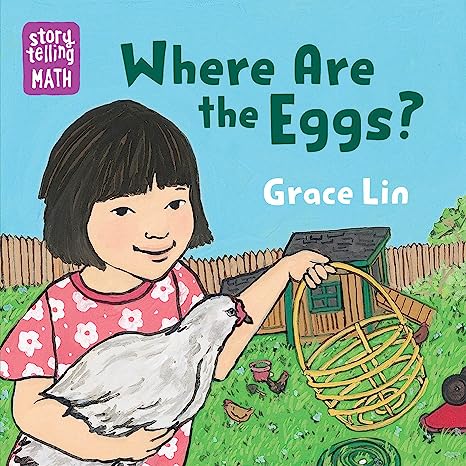 Where Are the Eggs?
Where Are the Eggs?
By Grace Lin. 2023.
Somerville, MA: Charlesbridge. 16 pp. Ages 0 to 3.
This is a fantastic board book that delves into math but also does so much more. It celebrates the joy of seeking and finding and highlights the relationship between a young girl, Mei, and the animals she cares for—without compromising on the simplicity that a board book should deliver. Mei leads readers through the garden to find the eggs that her chickens have laid, noting spatial relationships as she describes where she spots each egg (next to the watering can, in the middle of the garden hose). Lin (a Caldecott Honor recipient) uses a variety of gardening-related vocabulary (flowerpot, wheelbarrow). Mei’s tenderness for the chickens and their eggs also comes through. Children will enjoy the illustrations, which are warm and painterly yet still very clear.
The back matter walks teachers through spatial relationships and why they’re mathematically relevant. There is also a list of suggestions for other ways teachers can foster these math concepts in their own settings.
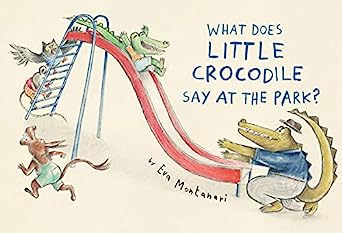 What Does Little Crocodile Say at the Park?
What Does Little Crocodile Say at the Park?
By Eva Montanari. 2022.
New York: Tundra Books. 40 pp. Ages 1 to 5
What a day! Little Crocodile’s grandparents take him on a walk to the playground, where he takes turns with friends on the equipment until it is time to go home. The simple story is told through a series of sounds, which children will love imitating and discussing. There’s the ding-dong of the doorbell and the “muah” of the grandpa’s kiss hello. On the walk to the park, there’s the swish of the lizard and the flap flap flap of the pigeons. After they arrive at the playground, there are the cries of “wwwwaah wwwwaah” when conflict breaks out on the merry-go-round. The little animal friends resolve the conflict themselves, without a caregiver needing to intervene.
This book was written with a childlike spirit front and center. Teachers can use it as a jumping off point for discussing sounds—those made by objects and those heard in nature—and feelings, and how the two match up.
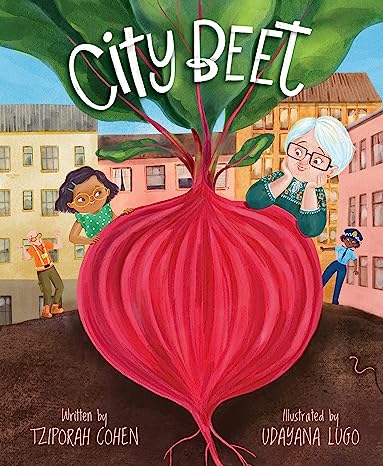 City Beet
City Beet
By Tziporah Cohen. Illus. by Udayana Lugo. 2023.
Ann Arbor, MI: Sleeping Bear Press. 40 pp. Ages 3 to 6.
When young Victoria and elderly Mrs. Kosta see a Save the Date for the summer potluck, they decide to prepare a raw beet and garlic salad together. They don’t want to just shop for the ingredients though; they want to grow them. But when potluck day arrives, their beet has gotten so big that they cannot get it out of the ground. Friends in the neighborhood—including taxi driver Mr. Wen, recycling truck driver Mr. Azizi, and police officers Deena and Tina—lend a hand. And still the beet won’t budge. Everyone keeps saying Victoria is too small to pitch in, but she proves that her creative thinking and muscle are just what they need.
Cohen based this story on a Russian folk tale but wanted to set her retelling in a city. She and Lugo portray a diverse community, including women wearing headscarves, a man wearing a turban, and a man wearing a yarmulke. Children love a story in which the child or smallest creature is the hero. This one even includes a recipe. Reading this book can be paired with cooking and gardening activities as well as family connections by sharing recipes and related stories in the classroom.
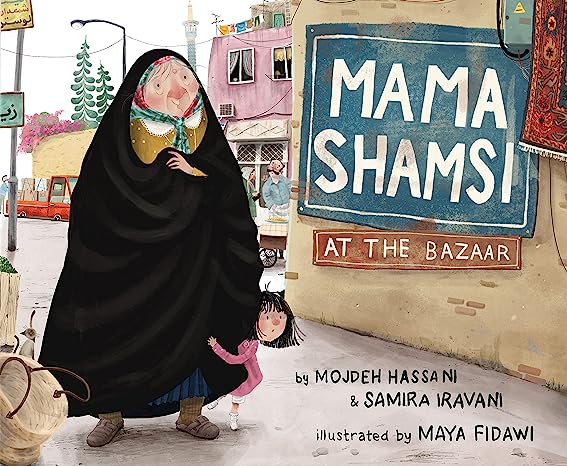 Mama Shamsi at the Bazaar
Mama Shamsi at the Bazaar
By Mojdeh Hassani and Samira Iravani. Illus. by Maya Fidawi. 2023.
New York: Dial Books for Young Readers. 40 pp. Ages 3 to 7.
Grandmother Mama Shamsi is taking Samira for her first outing to the big bazaar in Tehran. Samira has so many questions. Will it be loud? Will she get lost? She wants nothing more than to hide under her grandmother’s comforting black chador (head-to-toe cloak). Samira suggests different ways she could hide beneath it, and Mama Shamsi playfully rejects each one. If they walk in a line beneath the chador, as Samira suggests, they’ll look like a mule with four legs. If Samira rides on her grandmother’s shoulders, people will mistake them for a giraffe. Mama Shamsi has a better idea. They will hold hands, and Samira will use her very own eyes and ears and nose to explore the delights of the market. It’s just the right balance between nudging Samira’s independence and providing the safety she still needs.
The authors, who both have fond memories of playing underneath their grandmothers’ chadors, wanted to demystify the oft-maligned veil, and this humor-filled story does so. It’s a well-paced tale, invitingly illustrated, that gives readers a taste of the familiar (errands, getting lost, growing up) alongside an introduction to Iran’s capital city through its gorgeous architecture, sights, and street life.
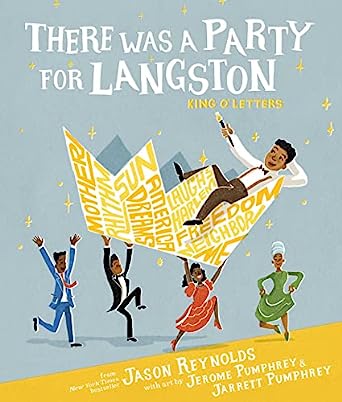 There Was a Party for Langston, King of Letters
There Was a Party for Langston, King of Letters
By Jason Reynolds. Illus. by Jerome Pumphrey and Jarrett Pumphrey. 2023.
New York: Atheneum. 56 pp. Ages 5 and up.
It’s a party! A joyful celebration of famous poet and writer Langston Hughes and his word-weaving magic is being held at the library in Harlem, and everyone important will be there. (Illustrations show that it is the 1991 grand opening of the Langston Hughes Auditorium at the newly expanded New York Public Library’s Schomburg Center for Research in Black Culture.) This book takes readers on a journey through Hughes’ life, meandering through art, civil rights history, and the impact he had on other literary greats, like Maya Angelou and Amiri Baraka. It balances exuberance for his work with the seriousness of Black history, both the struggles and the proud accomplishments.
Author Reynolds—an accomplished poet and writer himself—will make readers swoon for Hughes and want to dance alongside the revelers at the party. The book’s illustrators are brothers and collaborators who used handmade stamps to create the images. They integrate letters and words in interesting fonts into their bold illustrations in ways that make poetry and this story come alive.
Teachers can extend the book in the classroom by sharing a variety of poems with children.
Copyright © 2023 by the National Association for the Education of Young Children. See Permissions and Reprints at NAEYC.org/resources/permissions.
Isabel Baker, MAT, MLS, is the founding director of The Book Vine for Children, a national company dedicated to getting good books into the hands of preschool children and their teachers. Isabel has worked as a children’s librarian and is currently a presenter on early literacy and book selection.
Miriam Baker Schiffer, MFA, is a writer in Brooklyn, New York. She consults on book selections for The Book Vine, in McHenry, Illinois. Miriam’s children’s book, Stella Brings the Family, was published by Chronicle Books in 2015.